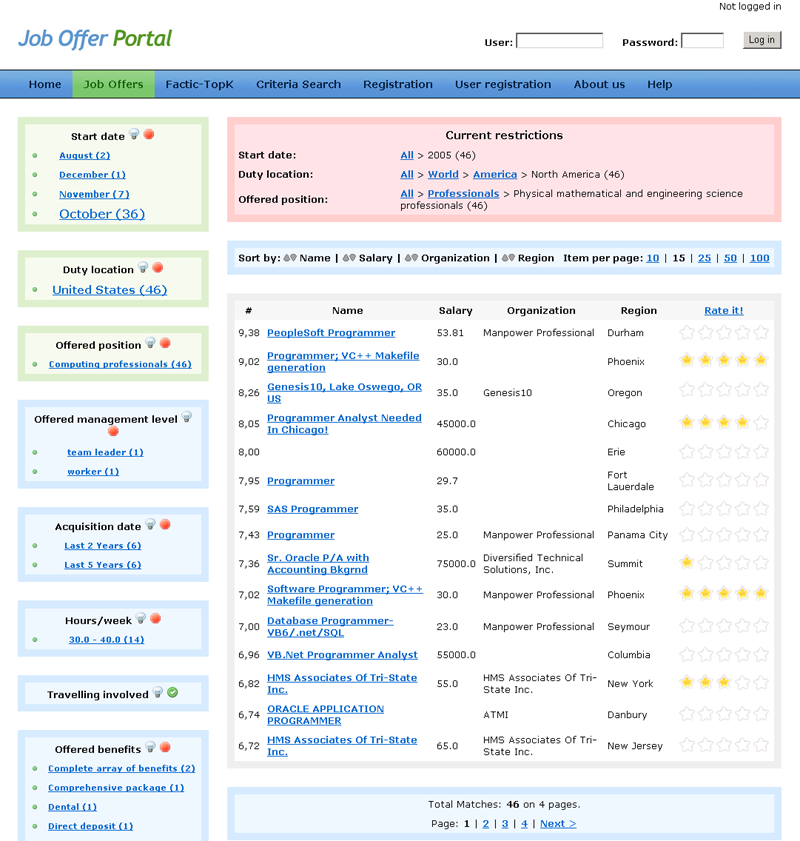|
Personalized Navigation in an Information Space Represented by an Ontology Michal Tvarožek Master thesis project supervised by prof. Mária Bieliková |
Motivation
The challenge of information processing is shifting from closed and relatively small information spaces towards open and comparatively large information spaces. In parallel, user expectations shift from simple lookup tasks towards more open-ended learning and investigative tasks collectively described as exploratory search. Consequently, effective means of search and navigation also considering the needs of individual users are required to improve end user experience with respect to finding, sorting and viewing relevant information.
An effective means to accomplish these goals is the intuitive integration of search and navigation via a faceted browser interface which allows users to visually construct queries and exploratively navigate the search results while further refining their search query. This can be best done if the semantics of the information are known or if it is well structured (e.g., described by an ontology).
Personalized faceted navigation
In our approach we extend the basic functionality of faceted browsers (i.e., the multidimensional restriction of the visible information space via facets) with support for automated personalization and user modeling using both implicit and explicit user feedback. We devised a multi-layered relevance model for "concepts" (e.g., facets, search results) based on:
- In-session usage characteristics of the current user.
- Short-term user characteristics discovered recently or in the current session.
- Long-term user characteristics indicating overall user preferences.
- User characteristics of similar and/or related users.
- Global user preferences and usage characteristics aggregated for all users.
- Adaptation and annotation of facets and restrictions based on the proposed relevance model.
- Personalized recommendation of facets, restrictions and search results.
- Multiple adaptive views optimized for current user needs with different visualizations and showing different properties of search results.
Evaluation
Our method is realized by the enhanced faceted browser Factic (see figure below) which was deployed in several application domains (job offers in project NAZOU and scientific publications in project MAPEKUS). We performed several experiments which showed that personalization improved overall task times, reduced the number of required clicks and also significantly improved GUI response times due to lower processing requirements.

Publications
- Tvarožek, M.
- Personalized Navigation in an Information Space Represented by an Ontology. Master thesis, Slovak University of Technology in Bratislava 2007.
 pdf (in Slovak)
pdf (in Slovak)
- Tvarožek, M., Bieliková, M.
- Adaptive faceted browser for navigation in open information spaces. In Proc. of the 16th Int. Conf. on World Wide Web (pp. 1311-1312). Banff, Alberta, Canada: ACM Press, New York, NY, USA.
- Tvarožek, M., Bieliková, M.
- Personalized Presentation in Web-Based Information Systems. In J. Van Leeuwen, G. F. Italiano, W. van der Hoek, H. Sack, C. Meinel, F. Plášil (Ed.), SOFSEM 2007: Proc. of the 33rd Conf. on Current Trends in Theory and Practice of Computer Science. LNCS 4362, pp. 796-807. Harrachov, Czech Republic: Springer-Verlag, Berlin Heidelberg.
- Tvarožek, M.
- Personalized Navigation in the Semantic Web. In V. P. Wade, H. Ashman, B. Smyth (Ed.), AH 2006: Proceedings of the 4th Int. Conf. on Adaptive Hypermedia and Adaptive Web-Based Systems. LNCS 4018, pp. 467-472. Dublin, Ireland: Springer-Verlag, Berlin Heidelberg.
| to Homepage | to Teaching | to the Top |
|
||
|
||